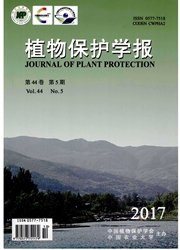

 中文摘要:
中文摘要:
为明确桃蛀螟Conogethes punctiferalis(Guenée)为害夏玉米果穗对产量的影响,于2012—2013年通过人工接种法将桃蛀螟初孵幼虫接到吐丝期玉米果穗上调查果穗被害程度,分析接虫密度对产量构成因素、穗腐病发生及产量损失的影响。结果表明,桃蛀螟主要通过降低百粒重、缩短果穗长度和减少行粒数等影响产量;当接虫密度每穗为1、3、5和10头时,不同处理的百粒重均比对照显著降低0.65、1.03、1.07和1.60 g;当接虫密度为每穗5和10头时,果穗长度比对照分别显著缩短9.66 mm和13.17 mm,行粒数减少5.15和5.45粒;桃蛀螟为害可诱发穗腐病的发生,主要病原菌为轮枝镰孢菌、青霉菌和禾谷镰孢菌,引起穗腐病的发生率分别为84.91%、54.45%和40.97%;接虫密度为每穗1、3、5和10头时,平均单穗产量损失率分别为0.73%、4.19%、11.65%和17.71%。研究表明,桃蛀螟为害不仅直接造成产量损失,还可加重穗腐病发生,影响玉米的质量。
 英文摘要:
英文摘要:
In order to clarify the effects of durian fruit borer Conogethes punctiferalis larvae's harming summer corn ears on the final yield,the corn ears were inoculated with C. punctiferalis neonates at silking stage during 2012 and 2013 by artificial method,and the effects of density of C. punctiferalis larvae on corn yield components,the incidence of ear rot,and yield losses were investigated. The results showed that C. punctiferalis influenced yield mainly by reducing one hundred-kernel weight,shortening ear length and decreasing the number of kernels in each row of the ear. In comparison with controls,the one hundred-kernel weights in different treatments of 1,3,5 and 10 larvae per ear were significantly decreased by 0. 65,1. 03,1. 07 and 1. 60 g,respectively. When the inoculated larval densities were 5and 10 larvae per ear, the ear lengths were significantly reduced by 9. 66 mm and 13. 17 mm,respectively,and the number of kernels in each row of the ear were significantly reduced by 5. 15 and5. 45,respectively. C. punctiferalis could also induce the ear rot disease,and the major pathogens were Fusarium verticillioide,Penicillium spp. and F. graminearum,with an occurrence rate of ear rot of84. 91%,54. 45% and 40. 97%,respectively. When the number of larvae was 1,3,5 and 10 per ear,the average yield loss per ear were 0. 73%,4. 19%,11. 65% and 17. 71%,respectively. The resultsindicated that the damage of C. punctiferalis larvae on corn ears could not only lead to yield loss directly,but also increase the occurrence rate of ear rot which affected the quality of corn grains.
 同期刊论文项目
同期刊论文项目
 同项目期刊论文
同项目期刊论文
 期刊信息
期刊信息
